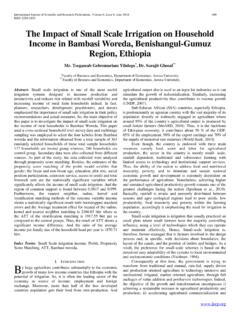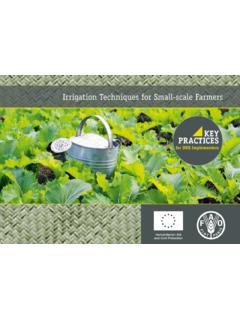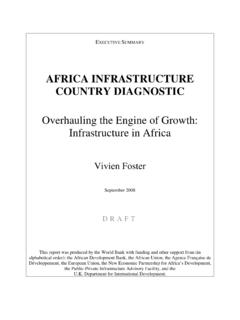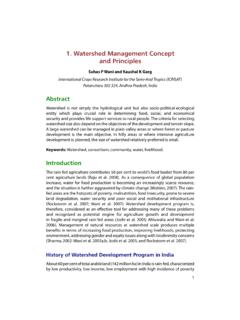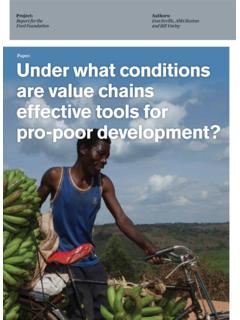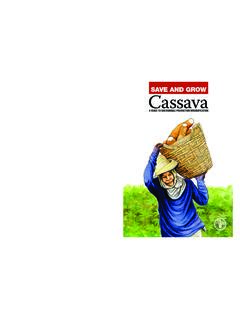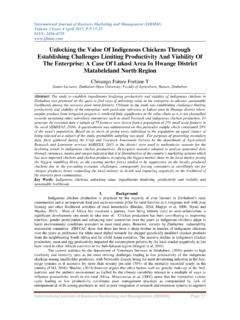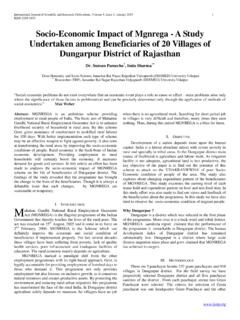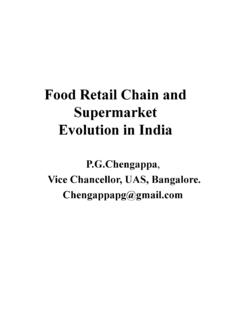Transcription of Petroleum Markets in Sub-Saharan Africa - World Bank
1 Extractive Industries for Development Series #15. Extractive Industries for Development Series #15. March 2010. Petroleum Markets in Sub-Saharan Africa Petroleum Markets in Sub-Saharan Africa : Analysis and Assessment of 12 Countries Analysis and Assessment of 12 Countries Masami Kojima with William Matthews and The World Bank Fred Sexsmith 1818 H Street, Washington, 20433. USA. (or /oil or /gas or /mining). (or /oil or /gas or /mining). Extractive Industries for Development Series #15. March 2010. Petroleum Markets in Sub-Saharan Africa Analysis and Assessment of 12 Countries Masami Kojima with William Matthews and Fred Sexsmith World Bank | Oil, Gas, and Mining Policy Division Working Paper Contents Abbreviations vi Acknowledgments vii Executive Summary 1. Factors Affecting Costs of Supplying Petroleum Products 1. Study Description 2. Infrastructure and market Structure 3.
2 Policies Affecting Fuel Prices 5. Gasoline and Diesel Price Levels in December 2008 8. Scope for Reducing Costs 9. 1 Bac kground 12. Study Description 14. Petroleum Product Supply Chain 16. Factors Affecting Price Levels 18. 2 Overview of the Downstream Petroleum Sector 24. Petroleum Product Consumption 24. Refining Capacities 25. Supply Infrastructure 27. market Structure 35. 3 Policies that Affect Price Levels 37. Legal Framework 37. Pricing Policy 41. Procurement 50. Policy toward Domestic Refineries 52. Extractive Industries for Development Series iii 4 Obser vations 54. Fuel Shortage 54. Refining 55. Natural Monopoly 56. Transporting Petroleum Products 56. Competition 58. Price Control 59. Overall Legal Framework and Enforcement 59. Valuation of Cost Reduction Potential in West Africa 61. Conclusions 61. References 64. Figures Retail Gasoline and Diesel Prices in December 2008 8.
3 Gasoline and Diesel Prices between 2004 and 2009 13. Petroleum Product Supply and Distribution Chain 17. Impact of market Size on Price Levels 19. Sector Structure and Policies Affecting Price Levels 23. Demand by Product and Country in 2007 25. Monthly Retail Gasoline Prices in West Africa (Jan. 2007 Jan. 2009) 45. Monthly Retail Kerosene Prices in West Africa (Jan. 2007 Jan. 2009) 46. Monthly Retail Diesel Prices in West Africa (Jan. 2007 Jan. 2009) 46. Retail Gasoline Prices in December 2008 47. Retail Diesel Prices in December 2008 48. Tables Study Coverage of Sub-Saharan African Countries 3. Study Coverage of Sub-SaharanAfrican Countries 15. Oil Refineries in Study Countries 26. Supply Arrangements and Logistics Infrastructure in West Africa 31. Supply Arrangements and Logistics Infrastructure in East and Southern Africa 33. iv Petroleum Markets in Sub-Sharan Africa market Structure Features of Study Countries 35.
4 Legal and Institutional Framework in the Downstream Petroleum Sector in West Africa 39. Legal and Institutional Framework in the Downstream Petroleum Sector in East and Southern Africa 40. Pricing Policy 42. Valuation of Potential Cost Reduction Measures in West Africa 62. Extractive Industries for Development Series v Abbreviations CIF cost, insurance, and freight DH Direction des Hydrocarbures (C te d'Ivoire). EWURA Energy and Water Utilities Regulatory Authority (Tanzania). FOB free on board GDP gross domestic product HHI Herfindahl-Hirschman index KPRL Kenya Petroleum Refineries Limited LPG liquefied Petroleum gas m3 cubic meters MEMD Ministry of Energy and Mineral Development (Uganda). MER market exchange rate MERA Malawi Energy Regulatory Authority NATREF National Petroleum Refiners of South Africa NOCK National Oil Corporation of Kenya OMC oil marketing company ONAP L' Office National des Produits P troliers (Mali).
5 PPP purchasing power parity SAFREF Shell and BP South African Petroleum Refineries SAR Soci t Africaine de Raffinage (Senegal). SIR Soci t Ivoirienne de Raffinage (C te d'Ivoire). SONABHY Soci t Nationale Burkinab d'Hydrocarbures (Burkina Faso). SONIDEP Soci t Nig rienne de D p t d'Essence et de P trole (Niger). All tonnes are metric tonnes. All dollar amounts are dollars unless otherwise indicated. vi Petroleum Markets in Sub-Sharan Africa Acknowledgments This report is based on two consultant studies, one in West Africa car- ried out by William Matthews and another in East and Southern Africa by Fred Sexsmith. The consultant reports are presented as annexes in the electronic report available at Masami Kojima of the Oil, Gas, and Mining Policy Division of the World Bank prepared this publication based on the consultant studies. The World Bank team who worked on the study includes Sanjoy Rajan, Robert Murphy, Masami Kojima, and Robert Bacon, all of the Oil, Gas, and Mining Policy Division.
6 The report benefited from helpful comments provided by three World Bank peer reviewers: Istvan Dobozi, Energy Sector Management Assistance Program; Dino Merotto, Poverty Reduc- tion and Economic Management, Europe and Central Asia Region; and Paivi Koljonen, Energy, Africa Region. The study was financed largely by the Energy Sector Management Assistance Program. Paula Whitacre edited this document, and Esther Petrilli-Massey of the Oil, Gas, and Mining Policy Division oversaw its production. Extractive Industries for Development Series vii Executive Summary Petroleum products are used across the entire economy in every country. Gasoline and diesel are the primary fuels used in road transport. Oil is used in power generation, accounting for 11 percent of total electricity generated in Africa in 2007. Adequate and reliable supply of transport services and electricity in turn are essential for economic development.
7 Households use a variety of Petroleum products: kerosene for lighting, cooking, and heating; liquefied Petroleum gas (LPG) for cooking and heating; and gasoline and diesel for private vehicles as well as captive power generation. Prices users pay for these Petroleum products have macroeconomic and microeconomic consequences. At the macroeconomic level, oil price levels can affect the balance of payments; gross domestic product (GDP);. and, where fuel prices are subsidized, government budgets, contingent liabilities, or both. At the microeconomic level, higher oil prices lower effective household income in three ways. First, households pay more for Petroleum products they consume directly. Seventy percent of Sub- saharan Africans are not yet connected to electricity; most without access rely on kerosene for lighting. Second, higher oil prices increase the prices of all other goods that have oil as an intermediate input.
8 The most signifi- cant among them for the poor in low-income countries is food, on which the poor spend a disproportionately high share of total household expen- ditures. Food prices increase because of higher transport costs and higher prices of such inputs to agriculture as fertilizers and diesel to operate tractors and irrigation pumps. For the poor who use transport services, higher transport costs also decrease effective income. Third, to the extent that higher oil prices lower GDP growth, household income is reduced. Factors Affecting Costs of Supplying Petroleum Products World oil prices increased four-fold between January 2004 and July 2008 and, after a sharp drop in the latter half of 2008, have been rising again. All sectors of the economy can benefit from an efficiently managed downstream oil sector that delivers Petroleum products in the quantity Extractive Industries for Development Series 1.
9 And at the quality required at least cost. For a given price of a Petroleum product on the World market , end-user prices net of taxes are affected by a number of factors: market size and economies of scale Mode of product transport in terms of cost per liter of fuel trans- ported over land, the least expensive is pipeline transport (in a hand- ful of cases in Sub-Saharan Africa that have the requisite scale econ- omy), followed by rail, and finally by trucks Liberalized versus controlled pricing Protection given to inefficient domestic suppliers Degree of competition Clear and stable legal framework with effective monitoring and enforcement Regular disclosure of industry statistics Study Description This regional study takes 12 oil-importing countries in Sub-Saharan Africa and asks the following two questions: Does each stage in the supply chain, from import of crude oil or refined products to retail, seem to be efficiently run and are the effi- ciency gains passed on to end-users?
10 If not, what are the potential causes and possible means of remedying the problems? The study focuses on Burkina Faso, C te d'Ivoire, Mali, Niger, and Senegal in West Africa and Botswana, Kenya, Madagascar, Malawi, South Africa , Tanzania, and Uganda in East and Southern Africa , covering a wide range of conditions that affect price levels, such as the market size, geography (whether landlocked or coastal), existence of domestic refin- eries, degree of sector liberalization including pricing, and level of eco- nomic development. The study relied on information collected during country visits by two consultants lasting an average of two days in each country (except Botswana and Malawi, for which information was collected through tele- phone calls and email) and publicly available information. The visits to the countries in East and Southern Africa took place in November 2008.










